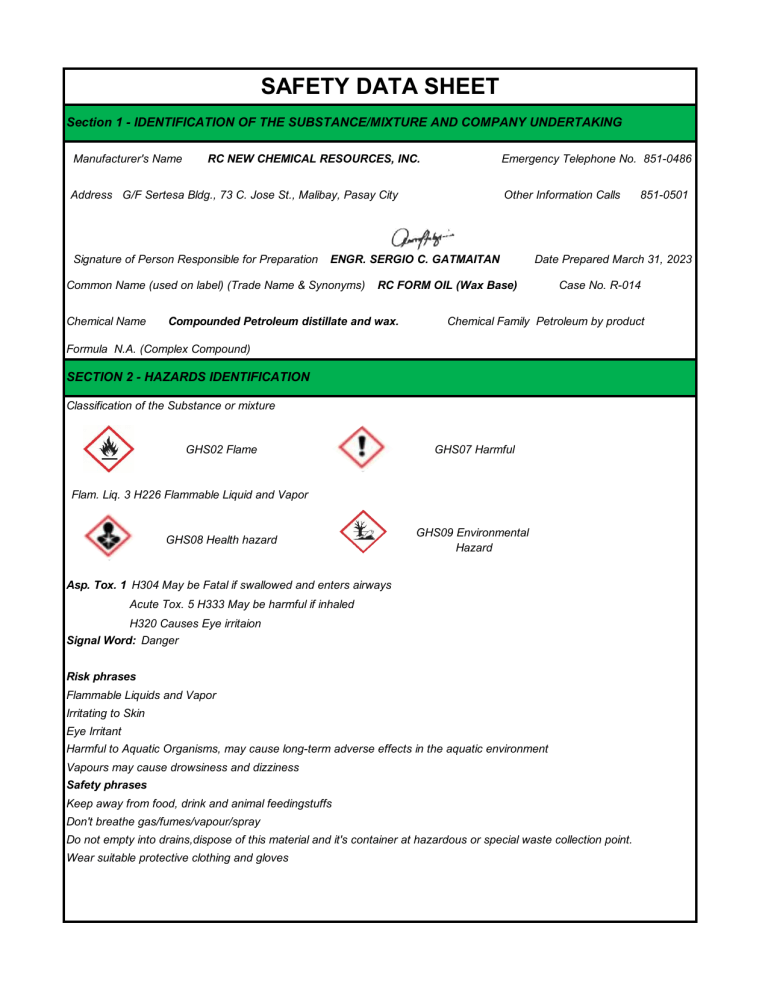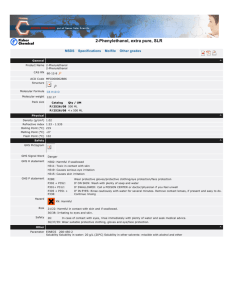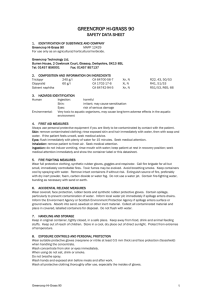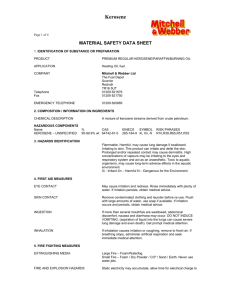
SAFETY DATA SHEET Section 1 - IDENTIFICATION OF THE SUBSTANCE/MIXTURE AND COMPANY UNDERTAKING Manufacturer's Name RC NEW CHEMICAL RESOURCES, INC. Emergency Telephone No. 851-0486 Address G/F Sertesa Bldg., 73 C. Jose St., Malibay, Pasay City Signature of Person Responsible for Preparation ENGR. SERGIO C. GATMAITAN Common Name (used on label) (Trade Name & Synonyms) Chemical Name Other Information Calls Date Prepared March 31, 2023 RC FORM OIL (Wax Base) Compounded Petroleum distillate and wax. Case No. R-014 Chemical Family Petroleum by product Formula N.A. (Complex Compound) SECTION 2 - HAZARDS IDENTIFICATION Classification of the Substance or mixture GHS02 Flame GHS07 Harmful Flam. Liq. 3 H226 Flammable Liquid and Vapor GHS08 Health hazard GHS09 Environmental Hazard Asp. Tox. 1 H304 May be Fatal if swallowed and enters airways Acute Tox. 5 H333 May be harmful if inhaled H320 Causes Eye irritaion Signal Word: Danger Risk phrases Flammable Liquids and Vapor Irritating to Skin Eye Irritant Harmful to Aquatic Organisms, may cause long-term adverse effects in the aquatic environment Vapours may cause drowsiness and dizziness Safety phrases Keep away from food, drink and animal feedingstuffs Don't breathe gas/fumes/vapour/spray Do not empty into drains,dispose of this material and it's container at hazardous or special waste collection point. Wear suitable protective clothing and gloves 851-0501 SECTION 3 - COMPOSITION / INFORMATION ON INGREDIENTS Chemical Characterizations: Mixtures Description: Mixture of substances listed below with nonhazardous additions. Dangerous components: CAS: 6472-81-0 EINECS: 265-184-9 CAS: 8008-20-6 EINECS: 232-366-4 Kerosene (petroleum), hydodesulfurized Xn R65 Asp. Tox. 1, H304 Kerosene (petroleum) Xn R20-48--65; Xi R38; F R11; N R51/53 R66-67 Asp. Tox. 1, H304; H227; H316 SECTION 4 - FIRST AID MEASURES Description of first aid measures General information: Symptoms of poisoning may even occur after several hours; therefore medical observation for atleast 48 hours after accident After Inhilation: In case of unconsciousness place patient stably in side position for transportation After skin contact: Immediately wash with water and soap and rinse thoroughly. After eye contact: Rinse opened eye for several minutes under running water After swallowing: If symptoms persist consult doctor. Information for doctor: Most important symptoms and effects, both acute and delayed , No further relevant information available. Indication of any immediate medical attention and special treatment needed. No further relevant information available. SECTION 5 - FIRE FIGHTING MEASURES Extinguishing media Suitable extinguishing agents: CO2, sand, extinguishing powder. Do not use water. For Safety reasons unsuitable extinguishing agents: Water with full jet. Advice for Firefighters Protective equipment: No special measures required. SECTION 6 - ACCIDENTAL RELEASE MEASURES Personal precautions, protective equipment and emergency procedures Wear protective equipment. Keep unprotected persons away. Environmental precautions: Do not allow product to reach sewage system or any water course. Inform respective authorities in case of seepage into water course or sewage system. Methods and meterial for containment and cleaning up: Absorb with liquid-binding material (sand, diatomite, acid binders, universal binders, saw dust). Dispose contaminated material as waste according to item 13. Ensuring adequate ventillation. Do not flush with water or aqueous cleansing agents. Reference to other sections: See section 7 (for safe handling), Section 8 (for Personal Protective Equipment), Section 13 (for disposal) SECTION 11 - TOXICOLOGICAL INFORMATION Information on toxicological effects Acute Toxicity: Incompatible materials: No further relevant information available. Primary irritant effect: On the skin: Irritant to skin and mucous membranes. On the eye: Irritant to eyes Senitization: No sensitizing effects known Additional toxicological information: The product shows the following dangers according to the calculation method of the General EU Classification Guidelines for the Preparations as issued in the latest version: Irritant SECTION 12 - ECOLOGICAL INFORMATION Toxicity Aquatic toxicity: Harmful to aquatic organisms. Persistence and degradability: No further relevant information available. Behaviour in environmental systems: Bioaccumulative potential: No further relevant information available. Mobility in Soil: No further relevant information available. Ecotoxical effects: Remark: Harmful to fish Additional ecological information: General notes: Water hazard class 3 (German Regulation) (Self-assessment): extremely hazardous for water Do not allow product to reach ground water, water course or sewage system, even in small quantities. Danger to drinking water if even extremely small quantities leak into the ground. Harmful to aquatic organisms. Results of PBT and vPvB assessment PBT: Not applicable. vPvB: Not applicable. Other adverse effects: No further relevant information available. SECTION 13 - DISPOSAL CONSIDERATIONS Waste treatment methods: Recommendation Must not be disposed together with household garbage. Do not allow product to reach sewage system. Uncleaned packaging: Recommendation: Disposal must be made according to official regulations. SECTION 14 - TRANSPORTATION INFORMATION Product can be transported by placing in steel drums. SECTION 7 - HANDLING AND STORAGE Handling: Precautions for safe handling Ensure good ventilation/exhaustat the workplace. Prevent formation of aerosols. Information about fire - and explosion protection: Keep ignition sources away - Do not smoke. Protect against electrostatic charges. Conditions for safe storage, including any incompatibilities Storage: Requirements to be met by storerooms and receptacles: No special requirements. Information about storage in one common storage facility: Not required. Further information about storage conditions: Keep container tightly sealed. Specific end use(s) No further relevant information available. SECTION 8 - EXPOSURE CONTROLS / PERSONAL PROTECTION Additional information about design of technical facilities: No further data; see item 7. Controls parameters Ingredients with limit values that require monitoring at the workplace: 64742-81-0 Kerosene (petroleum), hydrodesulfurized 100 mg/m3 REL (USA) TLV (USA) 200 mg/m3 as total hydrocarbon vapor; Skin; P 8008-20-6 Kerosene (petroleum) REL (USA) TLV (USA) 100 mg/m3 200 mg/m3 as total hydrocarbon vapor; Skin; P Additional information: The lists valid during the making were used as basis. Exposure controls Personal protective equipment: General protective and hygienic measures: keep away from foodstuffs, beverages and feed. Immediately remove all soiled and contaminated clothing Wash hands before breaks and at the end of work. Avoid contact with the skin. Avoid contact with the eyes and skin. Respiratory protection: In case of brief or low pollution use respiratory filter device. In case of intensive or longer exposure use self-contained respiratory protective device. Protection of hands: Protective Gloves The glove material has to be impermeable and resistant to the product/ the substance/ the preparation. Due to missing tests no recommendation to the glove material can be given for the product/ the preparation/ the chemical mixture. Material of gloves. The selection of the suitable gloves does not only depend on the material, but also on further marks of quality and varies from manufacturer to manufacturer. As the product is a preparation of several substances, the resistance of the glove material can not be calculated in advance and has therefore to be checked prior to the application. Penetration time of glove material The exact break through time has to be found out by the manufacturer of the protective gloves and has to be observed. Tightly sealed goggles SECTION 9 - PHYSICAL AND CHEMICAL PROPERTIES Information on basic physical and chemical properties. General Information Appearance: Form: Liquid Colour: Light Yellow Odour: Wax-like, petroleum Change in condition Melting Point/Melting Range: Undetermined Boiling Point/boiling range: 150 C Flashpoint: 38 C Ignition Temperature: 210 C Self-igniting: Product is not igniting Danger of Explosion: Product is not explosive, However, formation of explosive air/vapour mixtures are possible. Explosion Limits: Lower: 0.7 Vol % Upper: 5.0 Vol % Vapour pressure at 20 C : 0.3 hPa Density at 29 C: 9.4 - 9.6 lbs/gal (ASTM D1475) Solubility in / Miscibility with water: Not Soluble in water Solubility in / Miscibility with kerosene: Soluble in Kerosene SECTION 10 - STABILITY AND REACTIVITY Reactivity Chemical stability Thermal decomposition / condition to be avoided: No decomposition if used according to specifications. Possibility of Hazardous reactions: No dangerous reactions known. Conditions to avoid: No further relevant information available. Incompatible materials: No further relevant information available. Hazardous decomposition products: No dangerous decomposition products known. SECTION 15 - REGULATORY INFORMATION Safety, health and environment regulations/legislation specific for the substance or mixture. Philippines Inventory of Chemicals and Chemical Substances. 64742-81-0 Kerosene (petroleum), hydrodesulfurized 8008-20-6 Kerosene (petroleum) Chemical safety assessment: A Chemical Safety Assessment has not been carried out. SECTION 16 - OTHER INFORMATION This information is based on our present knowledge, However, this shall not constitute a guarantee for any specific features and shall not establish a legally valid contractual relationship. Relevant phrases. H227 Combustible Liquid H302 Harmful if swallowed H304 May be fatal if swallowed and enters airways. H316 Causes mild skin irritation. R11 Highly Flammable R20 Harmful by inhilation R22 Harmful if swallowed R38 Irritating to skin R40 Limited evidence of a carcinogenic effect. R48 Danger serious damage to health by prolonged exposure R50/53 Very toxic to aquatic organisms, may cause long-term adverse effects in the aquatic environment R51/53 Toxic to aquatic organisms, may cause long-term adverse effects in the aquatic environment R65 Harmful: may cause lung damage if swallowed. R66 Repeated exposure may cause skin dryness or cracking. R67 Vapours may cause drowsiness and dizziness. Department issuing SDS: Safety, Health and Environment Department.



